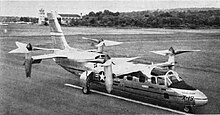A vertical take-off and landing (VTOL) aircraft is one that can take off and land vertically without relying on a runway. This classification can include a variety of types of aircraft including helicopters as well as thrust-vectoring fixed-wing aircraft and other hybrid aircraft with powered rotors such as cyclogyros/cyclocopters and gyrodynes.

A tiltrotor is an aircraft that generates lift and propulsion by way of one or more powered rotors mounted on rotating shafts or nacelles usually at the ends of a fixed wing. Almost all tiltrotors use a transverse rotor design, with a few exceptions that use other multirotor layouts.

A vertical and/or short take-off and landing (V/STOL) aircraft is an airplane able to take-off or land vertically or on short runways. Vertical takeoff and landing (VTOL) aircraft are a subset of V/STOL craft that do not require runways at all. Generally, a V/STOL aircraft needs to be able to hover. Helicopters are not considered under the V/STOL classification as the classification is only used for aeroplanes, aircraft that achieve lift (force) in forward flight by planing the air, thereby achieving speed and fuel efficiency that is typically greater than the capability of helicopters.

The Bell XV-15 is an American tiltrotor VTOL aircraft. It was the second successful experimental tiltrotor aircraft and the first to demonstrate the concept's high speed performance relative to conventional helicopters.

The Bell Helicopter Eagle Eye, Model 918, was an American tiltrotor unmanned aerial vehicle that was offered as one of the competitors in the United States Navy's VT-UAV program.

The Bell X-22 is an American V/STOL X-plane with four tilting ducted fans. Takeoff was to selectively occur either with the propellers tilted vertically upwards, or on a short runway with the nacelles tilted forward at approximately 45°. Additionally, the X-22 was to provide more insight into the tactical application of vertical takeoff troop transporters such as the preceding Hiller X-18 and the X-22's successor, the Bell XV-15. Another program requirement was a true airspeed in level flight of at least 525 km/h.
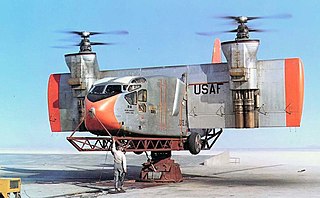
The Hiller X-18 was an experimental cargo transport aircraft designed to be the first testbed for tiltwing and V/STOL technology.

The Vultee XP-54 Swoose Goose was a prototype fighter built by the Vultee Aircraft Company for the United States Army Air Forces (USAAF).
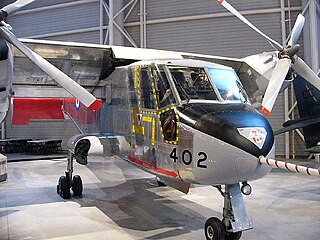
The Canadair CL-84 "Dynavert", designated by the Canadian Forces as the CX-131, was a V/STOL turbine tiltwing monoplane designed and manufactured by Canadair between 1964 and 1972. Only four of these experimental aircraft were built with three entering flight testing. Two of the CL-84s crashed due to mechanical failures, with no fatalities occurring in either of the accidents. Despite the CL-84 being successful in the experimental and operational trials carried out between 1972 and 1974, none of the prospective customers placed any orders for the type.

The Ling-Temco-Vought (LTV) XC-142 is a tri-service tiltwing experimental aircraft designed to investigate the operational suitability of vertical/short takeoff and landing (V/STOL) transports. An XC-142A first flew conventionally on 29 September 1964, and completed its first transitional flight on 11 January 1965 by taking off vertically, changing to forward flight, and finally landing vertically. Its service sponsors pulled out of the program one by one, and it eventually ended due to a lack of interest after demonstrating its capabilities successfully.

The Bell Model 309 KingCobra was an experimental attack helicopter developed by Bell Helicopter, based on the Bell AH-1 Cobra.
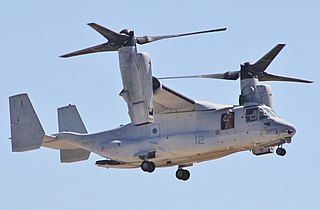
A powered lift aircraft takes off and lands vertically under engine power but uses a fixed wing for horizontal flight. Like helicopters, these aircraft do not need a long runway to take off and land, but they have a speed and performance similar to standard fixed-wing aircraft in combat or other situations.

The Piasecki VZ-8 Airgeep was a prototype vertical takeoff and landing (VTOL) aircraft developed by Piasecki Aircraft. The Airgeep was developed to fulfill a U.S. Army Transportation Research Command contract for a flying jeep in 1957. The flying jeep was envisioned to be smaller and easier to fly than a helicopter.

The Doak VZ-4 was an American prototype Vertical Takeoff and Landing (VTOL) aircraft built in the 1950s for service in the United States Army. Only a single prototype was built, and the U.S. Army withdrew it from active trials in 1963.

The Honeywell T55 is a turboshaft engine used on American helicopters and fixed-wing aircraft since the 1950s, and in unlimited hydroplanes since the 1980s. As of 2021, more than 6,000 of these engines have been built. It is produced by Honeywell Aerospace, a division of Honeywell based in Phoenix, Arizona, and was originally designed by the Turbine Engine Division of Lycoming Engines in Stratford, Connecticut, as a scaled-up version of the smaller Lycoming T53. The T55 serves as the engine on several major applications including the CH-47-Chinook, the Bell 309, and the Piper PA-48 Enforcer. The T55 also serves as the core of the Lycoming ALF 502 turbofan. Since the T55 was first developed, progressive increases in airflow, overall pressure ratio, and turbine inlet temperature have more than tripled the power output of the engine.

The Curtiss-Wright VZ-7 was a VTOL quadrotor helicopter aircraft designed by the Curtiss-Wright company for the US Army. Like the Chrysler VZ-6 and the VZ-8 Airgeep it was to be a "flying jeep".

The Dornier Do 29 was an experimental aircraft developed by Dornier Flugzeugwerke and the Deutsche Versuchsanstalt für Luftfahrt in the 1950s, used to test a tilting-propeller system for short takeoff and landing (STOL) aircraft. The concept was proved successful in flight testing; however, no further development of the system or aircraft was proceeded with, and at the conclusion of its test program the Do 29 was retired.

The Vertical Take-Off and Landing Experimental Aircraft program is an American research project sponsored by the Defense Advanced Research Projects Agency (DARPA). The goal of the program is to demonstrate a VTOL aircraft design that can take off vertically and efficiently hover, while flying faster than conventional rotorcraft. There have been many previous attempts, most of them unsuccessful.

The Transcend Air Vy 400 is a tiltwing convertible aircraft developed by American startup Transcend Air.
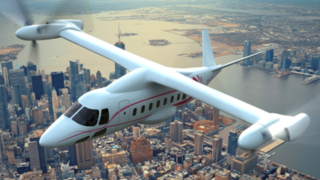
The Leonardo Next-Generation Civil Tiltrotor is a tiltrotor aircraft demonstrator designed and developed by the Italian aerospace company Leonardo S.p.A. Studies for a two times larger tiltrotor than the AgustaWestland AW609 started in 2000. Since 2014, its development is sponsored by the European Union's Clean Sky 2 program. By May 2021, major components were under production By 2023, the maiden flight had been pushed back to 2024, from a 2020 initial plan.

